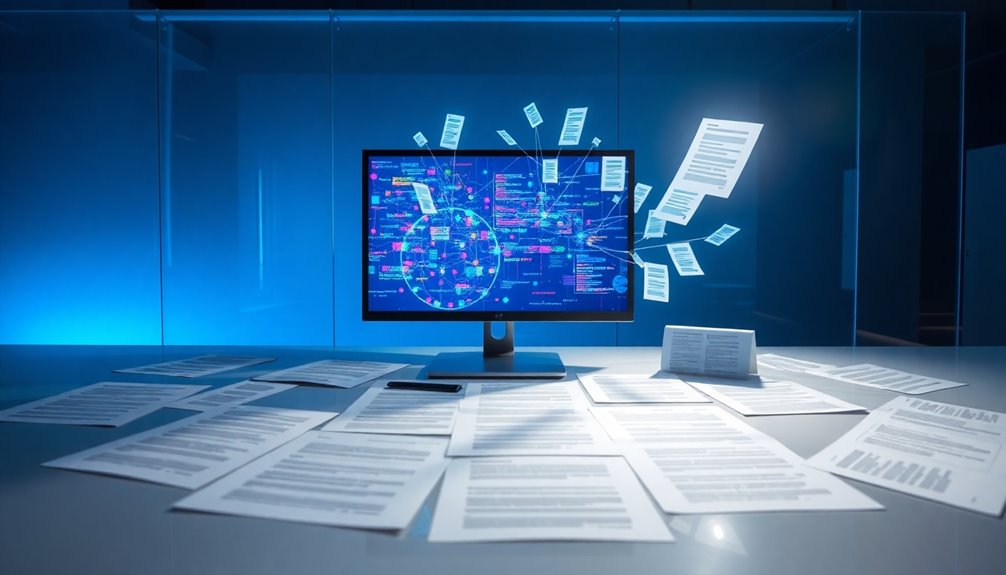A redacted text generator is a tool that helps you automatically censor sensitive information in documents, ensuring privacy and compliance with regulations like GDPR and HIPAA. It works by identifying keywords and patterns related to personal data or confidential information, then applying redaction techniques to mask or remove this data. These generators use advanced algorithms and AI to increase accuracy and efficiency, making the whole process much faster than manual redaction. With additional features like real-time editing and collaboration, you'll find these tools incredibly useful for secure information management. There's plenty more to explore about their benefits and features.
Definition of Redacted Text Generator
A redacted text generator is an online tool that helps you obscure or censor specific words or phrases in a document, protecting sensitive information from prying eyes.
These redaction tools are vital for anyone needing to remove sensitive information from legal documents, personal messages, or other contexts where confidentiality is paramount. Additionally, using strong passwords is crucial to protect any documents that may still reside on your WordPress site. Implementing a strong password policy can help safeguard these documents against unauthorized access.
The generator works by automatically identifying predefined patterns of confidential information, streamlining the redaction process for users. Instead of manually searching for sensitive content, you can rely on the tool to efficiently highlight and obscure the necessary text.
This feature saves you time and reduces the risk of human error, ensuring that no sensitive details slip through the cracks. Implementing security best practices can further enhance the protection of sensitive information during the redaction process.
Purpose of Redaction
Redaction serves a key role in protecting sensitive information, guaranteeing that privacy and confidentiality are upheld in various documents. When you redact sensitive information, you're not just covering up data; you're actively working to protect privacy and maintain trust. This process is essential for compliance with data protection regulations like GDPR, HIPAA, and CCPA, which require organizations to safeguard personal and sensitive information. Regular backups, including automated backups, can further enhance the security of sensitive information and support quick recovery in case of data loss.
By removing sensitive details, you help prevent unauthorized access to confidential data, greatly reducing the risk of identity theft, fraud, and data breaches. Whether you're dealing with legal documents, medical records, or corporate files, proper redaction is fundamental. It guarantees that specific information remains confidential and complies with industry standards.
Moreover, effective redaction maintains client and stakeholder trust. When others see that you've taken steps to protect their sensitive information, they feel more secure sharing their data with you. Regular data protection measures, such as regular backups, further enhance the security of sensitive information.
Ultimately, redaction isn't just about obscuring text; it's about creating a safer environment for everyone involved. By understanding the purpose of redaction, you can appreciate its importance in today's information-driven world.
How Redacted Text Generators Work

To understand how redacted text generators work, you first need to see how they identify sensitive information.
These tools use predefined patterns or keywords to pinpoint what needs to be obscured. In addition, employing strong passwords can help protect the original documents from unauthorized access before redaction. Furthermore, utilizing automated backups can ensure that any original documents are safely stored in case of errors during the redaction process.
Once identified, they apply redaction techniques to guarantee that the sensitive data is permanently removed from your documents. Additionally, implementing data encryption can further safeguard sensitive information during the redaction process.
Identification of Sensitive Information
When dealing with documents that contain sensitive information, redacted text generators play an essential role in identifying and protecting that data.
These tools utilize algorithms that automatically identify patterns of sensitive information, including names, addresses, and financial details. By employing predefined keywords and phrases, the software guarantees compliance with data protection regulations, making the identification of sensitive information both efficient and reliable.
Redaction software can distinguish between various types of sensitive data, such as personal identification information and proprietary corporate data. This targeted approach allows for precise automated redaction, guaranteeing that only the necessary information is concealed.
Many redaction tools come with customizable settings, letting you define what constitutes sensitive information based on your specific context or industry.
Once the software identifies sensitive information, it replaces it with visual indicators, like black bars or placeholder text. This maintains the document's structure while effectively concealing the data.
Application of Redaction Techniques
As you navigate the complexities of document management, understanding how redacted text generators work can greatly streamline your workflow.
These innovative tools utilize advanced algorithms to automatically identify and redact sensitive data, ensuring compliance with data protection regulations. Instead of manually searching for confidential information, you can rely on these generators to obscure it efficiently.
When you use a redacted text generator, it typically replaces sensitive text with black bars or placeholder symbols, maintaining the document's structure while protecting confidential details.
Many of these tools support multiple file formats like PDFs and Word documents, allowing you to process various types of files seamlessly.
To enhance efficiency, redacted text generators often feature bulk editing and customizable settings. This means you can tailor the redaction techniques to fit your specific needs, saving you time and effort.
Additionally, advanced redaction tools incorporate AI and machine learning, improving their accuracy in identifying a wider range of sensitive data. This reduces the risk of human error during the redaction process, giving you peace of mind that your documents are secure and compliant.
Types of Data for Redaction
When it comes to redaction, you'll encounter various types of sensitive data that need protection. Personal identification information, confidential business data, and legal and medical records all require careful handling to maintain privacy and security. Understanding these categories is essential for effective redaction practices. Regular backups can help ensure that sensitive data is not lost during the redaction process, making data protection a crucial aspect of managing sensitive information. Additionally, implementing a reliable backup strategy can enhance the security of sensitive data during the redaction process. Utilizing a trusted backup plugin, like UpdraftPlus, can streamline the backup process and provide peace of mind.
Personal Identification Information
Personal Identification Information (PII) encompasses various types of sensitive data that must be redacted to safeguard individual privacy. This includes names, addresses, phone numbers, Social Security numbers, and email addresses. When exposed, this personal information can lead to identity theft, fraud, and unauthorized access to your accounts.
That's why redaction is essential for compliance with regulatory requirements like GDPR, HIPAA, and CCPA.
In many cases, redaction of PII is mandated in legal documents, healthcare records, and financial statements. Organizations must implement effective redaction techniques to prevent data breaches and maintain client trust. Even a single unredacted piece of information can compromise security.
To enhance efficiency and accuracy, automated tools are increasingly used to identify and obscure PII in large volumes of documents. These tools help guarantee that the final output, or redacted text, complies with legal and regulatory standards while protecting sensitive data.
Confidential Business Data
Confidential business data consists of several vital categories that require careful redaction to protect a company's competitive edge and maintain client trust. One key category is trade secrets, which include proprietary formulas and strategies that, if disclosed, could give competitors an unfair advantage. It's important to safeguard this information through effective redaction.
Additionally, sensitive information, such as financial reports and client details, must be handled with care. When drafting contracts or proposals, redacting client information like contact details and project specifics is significant to guarantee confidentiality during negotiations.
Furthermore, you should consider sensitive communications, such as emails containing strategic business plans, as these may also require redaction.
Regulatory compliance further emphasizes the need for redaction in specific scenarios. For instance, any health-related information tied to employee medical records must be redacted to adhere to laws like HIPAA.
Legal and Medical Records
Legal and medical records often contain sensitive information that requires careful redaction to protect the privacy and safety of individuals.
In legal documents, you typically need to redact witness names, case numbers, and settlement amounts to maintain confidentiality. If this information gets exposed, it could lead to serious repercussions for those involved.
Similarly, medical records must have personally identifiable information (PII) removed, including patient names, addresses, and medical history. This is vital for compliance with privacy laws such as HIPAA.
Both types of records can also contain proprietary information that, if disclosed, might jeopardize the safety or privacy of individuals or organizations.
The redaction process in these contexts is essential for preventing identity theft, fraud, and potential legal liabilities related to mishandling sensitive information.
To streamline this process, automated redaction tools are becoming increasingly popular in the legal and medical fields. These tools help you efficiently process large volumes of documents while ensuring compliance with regulatory standards, making it easier to protect sensitive information without sacrificing time or accuracy.
Redaction Methods and Technologies

When dealing with sensitive information, choosing the right redaction method is crucial. You want to guarantee that the information is effectively protected while maintaining document integrity.
Here are some common redaction methods to take into account:
- Manual Techniques: Blacking out text is a straightforward way to obscure sensitive information.
- Automated Processes: Software programs can efficiently identify and redact predefined patterns without much manual intervention.
- AI-Assisted Redaction: Advanced technologies leverage machine learning and natural language processing to enhance accuracy, identifying a broader range of sensitive information types. Additionally, cloud storage solutions can facilitate safe and scalable storage for the redacted documents.
- Conversion-Based Redaction: Changing document formats after redaction minimizes the risk of residual sensitive data being accessible. Additionally, utilizing secure cloud storage solutions can provide data accessibility for backup copies of redacted documents.
Automated redaction tools are particularly beneficial when you're handling large volumes of documents, as they appreciably reduce processing time. Additionally, employing secure cloud storage solutions can help ensure that backup copies of redacted documents remain protected against unauthorized access.
These tools guarantee that sensitive text is permanently removed, minimizing the risk of data leakage. By incorporating AI-assisted redaction, you can achieve even greater accuracy in identifying sensitive information.
Selecting the best redaction method for your needs will help safeguard your data and maintain compliance with privacy regulations.
Benefits of Using Redacted Text Generators
Using redacted text generators offers numerous advantages that can greatly enhance your data protection efforts.
These powerful redact tools automatically identify and obscure sensitive information, considerably reducing the risk of unauthorized access. By streamlining the redaction process, you can save time and effort compared to labor-intensive manual methods that are often prone to human error.
Moreover, these generators guarantee compliance with legal and regulatory standards, such as GDPR and HIPAA, by effectively protecting personal and confidential information in your documents. This compliance is vital for maintaining your organization's integrity and avoiding potential legal repercussions.
Additionally, many redacted text generators support various file formats, making them versatile tools for different industries, including legal, healthcare, and finance.
You'll find customizable redaction options that allow you to tailor the process to meet your specific privacy needs and documentation requirements.
Common Use Cases

Redacted text generators have become essential tools across various industries, providing practical solutions for protecting sensitive information.
These tools are invaluable for maintaining compliance with various regulations and safeguarding privacy.
Here are some common use cases:
- Legal Settings: Protects sensitive information in court documents, ensuring confidentiality and compliance with legal standards.
- Healthcare: Redacts patient information from medical records, helping organizations meet HIPAA regulations and maintain patient privacy.
- Government Agencies: Censors classified or sensitive data before public release, vital for maintaining national security.
- Financial Institutions: Obscures personal identifiers in financial statements and applications, reducing the risk of fraud and unauthorized disclosure.
Features of Effective Redaction Tools
When choosing a redaction tool, you want a user-friendly interface that makes navigation simple and efficient.
Advanced security measures are also essential, ensuring that any redacted information stays protected from unauthorized access.
These features not only save you time but also help maintain compliance with legal standards.
User-Friendly Interface
A user-friendly interface is essential for effective redaction tools, as it allows you to navigate features effortlessly. You want a tool that's easy to use, especially when dealing with sensitive information.
An intuitive design can markedly reduce the learning curve, making it suitable for both technical and non-technical users.
Key features of a user-friendly interface include:
- Drag-and-drop functionality for quick identification and removal of sensitive information.
- Real-time editing and preview capabilities so you can see changes immediately and make accurate adjustments.
- Cross-platform compatibility that guarantees access across various devices and browsers, accommodating your workflow.
- Accessible help resources, like tutorials and customer support, that guide you through using redaction features.
These elements not only enhance your efficiency but also provide the support you need to feel confident while redacting documents.
With a user-friendly interface, you can focus on what matters most—protecting sensitive information without the hassle of complicated tools.
Advanced Security Measures
Advanced security measures are essential for any effective redaction tool, ensuring that sensitive information remains protected throughout the redaction process. By using advanced algorithms like AI and machine learning, these tools can automatically identify and redact sensitive information with impressive accuracy, often surpassing 90% compared to manual methods. This means you can trust that redacted information is handled securely.
Moreover, customizable settings allow you to define specific data types for redaction, ensuring compliance with HIPAA regulations and other relevant standards. This customization is vital for businesses that handle sensitive health data or personal information.
You'll also appreciate that effective redaction tools guarantee the permanent removal of sensitive text, preventing any chance of recovery through metadata or document properties.
Additionally, many tools offer real-time editing and collaboration features, letting multiple users work on documents simultaneously while maintaining security. With support for bulk processing, you'll find that these advanced security measures greatly reduce the time needed for redaction tasks, enhancing your overall efficiency in managing sensitive data.
Comparison of Manual vs. Automated Redaction

Redaction methods can greatly impact the efficiency and accuracy of handling sensitive information.
When you consider manual vs. automated redaction, the differences are striking:
- Labor-Intensive vs. Efficient: Manual redaction requires painstaking effort, while automated redaction handles large volumes quickly.
- Human Error Risk: Manual methods often lead to mistakes, but automated tools achieve up to 91% redaction accuracy.
- Residual Data Issues: Manual redaction may leave behind hidden data, whereas automated tools effectively remove metadata and revision history.
- Consistency: Automated redaction guarantees uniform application of redaction standards, reducing oversight risks common in manual processes.
Challenges With Traditional Redaction Methods
While automated redaction tools offer considerable advantages, traditional methods still pose numerous challenges. Manual redaction techniques, like blacking out text, are labor-intensive and often lead to human error. This increases the risk of accidentally exposing sensitive information, which can have serious consequences.
When working in time-sensitive industries, such as legal and healthcare, the inefficiency of these manual processes can cause delays in handling large volumes of documents.
Additionally, traditional redaction methods frequently overlook hidden data in file properties, including metadata and revision history. This oversight can compromise document security and lead to further complications.
Inconsistent application of redaction standards across different documents is another major challenge. This inconsistency can result in compliance issues and potential legal penalties, adding stress to your workflow.
Given the reliance on human judgment, the likelihood of oversight rises considerably. This is where specialized redaction software becomes essential. By automating the redaction process, you can improve accuracy and guarantee that sensitive information is adequately protected, ultimately enhancing your ability to comply with regulations and maintain document integrity.
Compliance and Legal Considerations

Compliance with data protection regulations is vital for organizations maneuvering today's complex legal landscape. Failure to adhere to these regulations can result in hefty penalties and damage to your reputation.
To effectively manage sensitive information, you need to reflect on the following legal requirements:
- Understand key regulations like GDPR, HIPAA, and CCPA.
- Implement redaction practices to protect personal and financial data.
- Conduct regular audits to guarantee compliance with evolving standards.
- Train staff on the importance of safeguarding sensitive information.
In industries such as healthcare and finance, redaction isn't just a best practice; it's a legal requirement. The California Penal Code 741 highlights the importance of fair evaluation in legal processes, which can be supported by proper redaction of identifying information.
By adopting effective redaction strategies, you can mitigate risks of identity theft and unauthorized disclosure. Regular assessments of your redaction practices are essential to adapt to changing legal landscapes.
Securing compliance isn't just about protecting data; it's about fostering trust with your clients and stakeholders. Prioritizing these reflections will keep your organization on the right side of the law while safeguarding sensitive information.
Getting Started With Redaction Tools
Understanding the importance of protecting sensitive information sets the stage for effectively using redaction tools. Getting started with these tools is simple and intuitive. You can either input text directly or upload documents that contain sensitive information.
Most redaction tools feature user-friendly interfaces, making it easy for you to navigate through the process. Before you finalize your redacted documents, take advantage of the preview feature. This allows you to see how the final version will look, guaranteeing you haven't missed anything critical.
You can often customize your redaction settings to target specific types of sensitive information, such as names, addresses, or financial details. If you have multiple documents to redact, look for options that support bulk editing. This will save you time and increase efficiency.
Importantly, verify that the redaction tools you choose permanently remove the sensitive information from your files. This compliance with data protection regulations enhances security and peace of mind.
Once you're satisfied with your redactions, don't forget to save the file. This way, you'll have a secure, compliant document ready for distribution or storage.
Future Trends in Redaction Technology

As redaction technology evolves, it's clear that innovative trends are set to reshape how we protect sensitive information.
You'll witness advancements that not only enhance efficiency but also improve accuracy in identifying sensitive data. Here are some exciting trends to look out for:
- Real-time redaction: Tools will allow you to redact sensitive information on-the-fly during document creation or sharing.
- Natural language processing: Improved capabilities will help tools better understand context, enabling them to automatically search for a wider variety of sensitive data formats.
- Cloud-based redaction solutions: These solutions will become more popular, offering enhanced accessibility and collaboration features for handling large volumes of documents seamlessly.
- Automated compliance reporting: With increasing regulatory pressures, future redaction technologies will include features that guarantee adherence to compliance requirements efficiently.
Conclusion
In a world brimming with sensitive information, a redacted text generator isn't just a tool—it's your safeguard against potential breaches. By streamlining the redaction process, you can protect privacy while maintaining clarity. As technology evolves, embracing these innovative solutions isn't just smart; it's vital. So, why risk exposing confidential data when an effective solution is at your fingertips? Make redaction a priority, and guarantee your information stays safe and sound.



